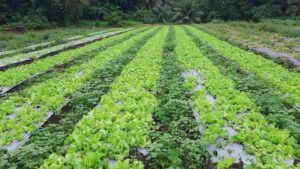
PGS Organic Farm in French Polynesia. Photo Credit: Moetini Moutame.
Biodiversity, the variety of life on earth, is the foundation for all agriculture – from the food we eat to the ecosystem services we rely on for production. It is the foundation of human survival in terms of:
On land, the Pacific Islands are home to approximately 5,330 native plant species, 242 native bird species, 61 native terrestrial reptiles, 15 native mammals, three endemic native amphibians and some 4,000 snail species.
The majority of these creatures are found nowhere else on earth[1], are found on small specific island habitats, and are vulnerable to extinction. Climate change impacts and climate events, deforestation, invasive species, and industrial agricultural practices have greatly impacted on the Pacific’s biodiversity.
Traditional agro-forestry systems in the Pacific are naturally diverse but can also be improved by increasing agro-biodiversity through organic agriculture practices such as integrated crop-tree animal systems, use of microorganisms and companion or other useful plants.
This, together with inter-cropping, the use of traditional and underutilized food and fodder species creates habitats, attracts pest enemies and pollinators and also reduces the risk of crop failure across the agro-ecosystem.
Organic agriculture has the potential to improve and restore the health of ecosystems by employing sustainable farming techniques that promote and sustain biodiversity – from the diversity of microorganisms and biological activity in the soil to a diverse selection of perennial, hardy and resilient crops and trees.
Organic agriculture sustains biodiversity by promoting:
These practices enhance not only biodiversity, but strengthen natural cycles and improve environmental performance that in turn increases the sustainability of organic farms.
[1] Donoghue, M. (2012). Pacific Islands and Ocean Program. Retrieved January 23, 2014, from Convention International: http://www.conservation.org/Documents/Pacific_Islands_Program_Factsheet.pdf